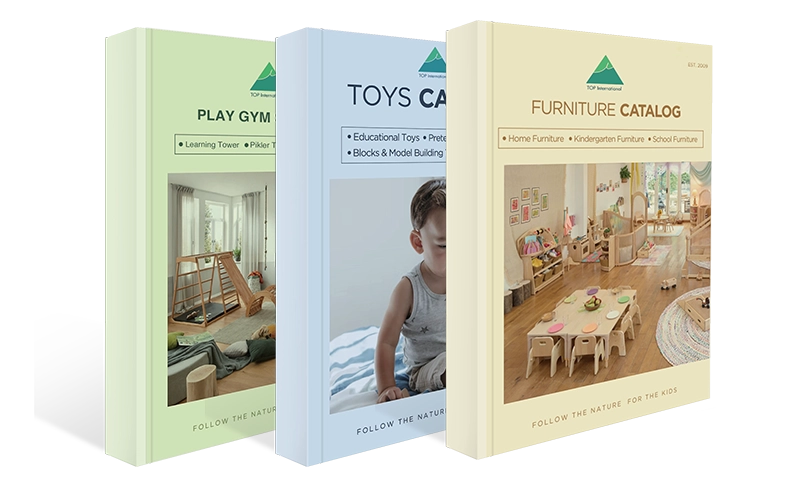Are you struggling to keep your toddler entertained in a meaningful way? Do you wonder how to support their learning without screens or gadgets? Are you looking for simple, hands-on activities that can engage their senses, build skills, and spark imagination—all at the same time? Sensory bins for toddlers are the perfect solution: screen-free, skill-building, and endlessly engaging.
Sensory bins for toddlers are the perfect solution. These engaging, low-cost tools provide young children a safe space to explore textures, colors, shapes, and sounds. They stimulate curiosity, build fine motor skills, develop cognitive abilities, and encourage early language use. Most importantly, they turn everyday play into powerful learning experiences, helping toddlers grow creatively, emotionally, and intellectually.
In the following article, I’ll share 50 fun, educational, and easy-to-prepare sensory bin ideas for toddlers. Whether you’re a parent, educator, or daycare provider, these ideas will inspire you to create memorable learning moments for your toddler, so keep reading and get ready to spark some sensory magic.
What is a Sensory Bin?
A sensory bins for toddlers is more than just a box filled with stuff—it’s a carefully curated educational tool designed to stimulate your child’s five senses through hands-on exploration. Whether you’re a preschool director, daycare owner, or early childhood educator, incorporating sensory bins for toddlers into your curriculum can dramatically boost engagement, attention, and developmental progress. These bins can be made using basic, everyday materials or fully customized to align with learning themes and seasonal topics.
At its core, a sensory bin introduces toddlers to textures, colors, and sounds, helping them explore and understand their world. While many might think it’s just messy play, the benefits of sensory bins for toddlers include language development, fine motor skill enhancement, cognitive stimulation, and emotional regulation. For educators working with limited budgets, easy sensory bins for toddlers offer affordable ways to deliver maximum developmental value.
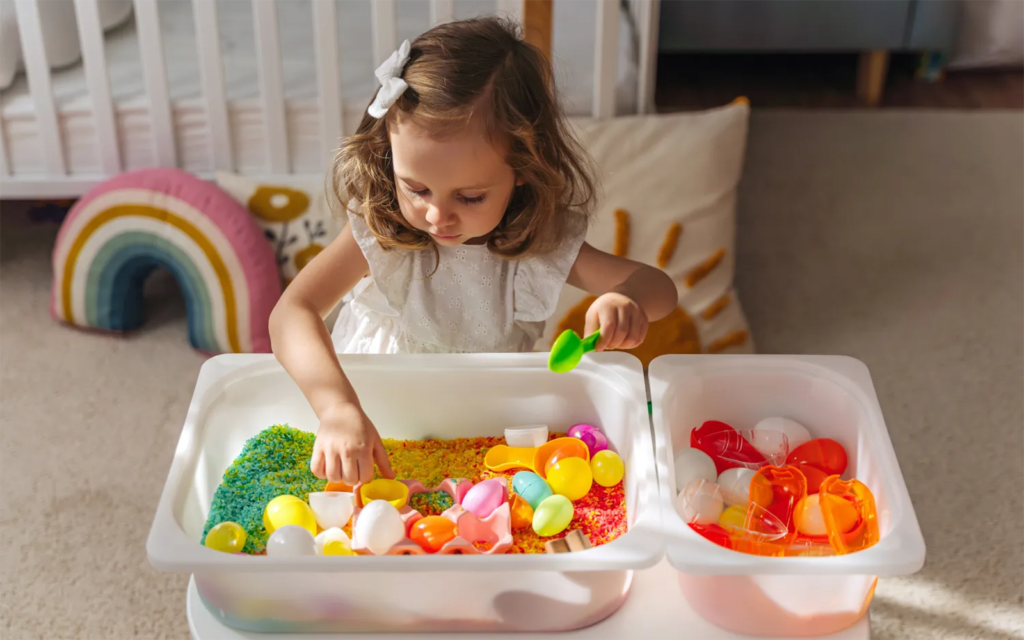
Visual (Sight)
Among the five senses, sight is typically the first sense toddlers develop when interacting with a bin. Visually engaging setups attract attention and encourage focus. Sensory bins for toddlers that target visual exploration might include colorful pom-poms, rainbow rice, neon water beads, or mini figures in bold shapes. These items not only entertain but also support color recognition and spatial awareness.
A good example of easy sensory bin ideas for toddlers is a color-sorting bin. By placing different colored objects into matching cups or zones, children begin to understand classification, sequence, and pattern recognition—skills critical to pre-math development. Add mirrors or transparent materials on a light table, and you’ve created one of the best sensory bins for toddlers focused on visual learning.
Auditory (Hearing)
Though often overlooked, the auditory sense plays a key role in learning and memory development. Bins filled with noise-related materials—like dried beans, pasta shells, bells, or aluminum foil—can transform into exciting sensory bins for toddlers that teach cause and effect.
For example, shaking a plastic container filled with beads allows children to explore rhythm and volume. You can add musical elements to a sensory bin table for toddlers, creating a rhythm center perfect for group play and cooperative learning. These sensory bins for toddlers also encourage verbal expression as children describe what they hear or try to imitate sounds.
Simple sensory bin tools for toddlers, like measuring cups, wooden spoons, or metal trays, can elevate the experience. Toddlers love the sensory feedback from tapping, scooping, or pouring—and educators will appreciate how these activities also build listening skills, auditory processing, and self-awareness.
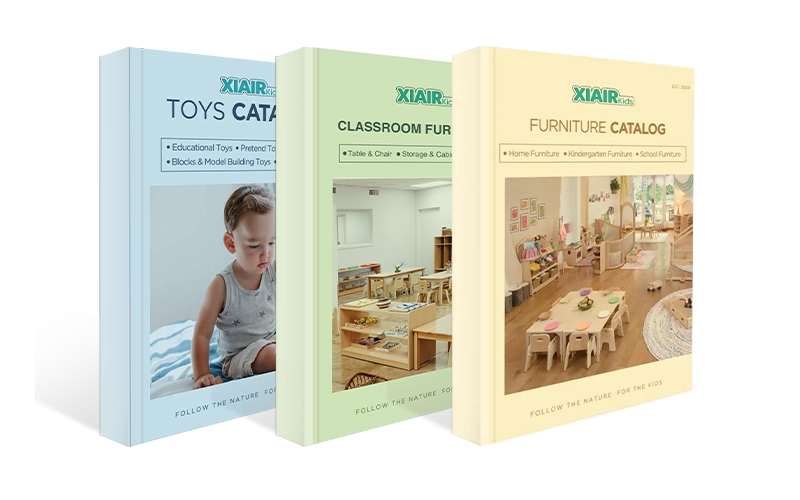
Receive a free catalog and custom layout to help you design your ideal classroom easily.
Tactile (Touch)
The tactile experience lies at the heart of every sensory bins for toddlers. Children explore the world with their hands when they dig, scoop, and squish. These sensations help form neural connections in the brain, making tactile play one of the most impactful types of learning.
Materials like kinetic sand, shaving cream, flour, and cotton balls are perfect for creating easy sensory bins for toddlers that support motor skill development and emotional regulation. A well-designed sensory bin activity for toddlers engages their curiosity and helps strengthen muscles needed for pencil grip, buttoning clothes, and using scissors in later years.
For a seasonal example, a Christmas sensory bins for toddlers could include faux snow, pinecones, and small presents. This festive setup engages touch and creates opportunities for storytelling, pretend play, and group collaboration. When paired with sensory bin tools for toddlers, like scoops and tweezers, these activities enhance fine motor precision and bilateral coordination.
Olfactory (Smell)
Smell is a powerful trigger for memory and association, and sensory bins for toddlers with scent elements can enrich the sensory experience. Dried herbs like rosemary and lavender, citrus peels, or cinnamon sticks can be added to tactile materials like rice or sand to create immersive, thematic environments.
For example, a fall-themed bin might include cinnamon-scented rice and miniature pumpkins, evoking an intense seasonal atmosphere. These sensory bins for toddlers also help support vocabulary development as children learn to describe smells and associate them with specific items or times of year.
Using safe, non-toxic essential oils in moderation can add another layer of learning. However, educators should always check for sensitivities and allergies when planning homemade sensory bins for toddlers with olfactory elements.

Gustation (Taste)
Although taste is the least engaged sense in classroom-based sensory bin activities for toddlers, it still plays a role, especially for younger children exploring the world orally. In these cases, homemade sensory bins for toddlers with edible materials provide a safe, enjoyable option for sensory play.
Consider using edible play-dough, flavored gelatin, or crushed cereal in your bin. These make easy sensory bins for toddlers that support oral and tactile exploration. Under careful supervision, these bins also teach early food texture tolerance, which is especially beneficial for picky eaters or children with sensory sensitivities.
Because taste-oriented bins can be messier, they’re often best suited for small groups or one-on-one sessions. When done right, however, they offer some of the most memorable and impactful sensory experiences for toddlers.

Receive a free catalog and custom layout to help you design your ideal classroom easily.
Benefits of Sensory Bins for Toddlers That Every Preschool Should Know
From language to motor skills, math readiness to emotional regulation, the benefits of sensory bins for toddlers extend across every area of early childhood development.
Facilitates Sensory Exploration
Toddlers are wired to explore through their senses, so sensory bins are foundational to any high-quality early learning environment. They allow children to safely engage in multi-sensory play using materials that stimulate touch, sight, and sound.
By introducing easy sensory bin ideas for toddlers, such as dried beans with measuring cups or kinetic sand with small animal figures, we help toddlers fine-tune their sensory processing. Children learn to distinguish between textures, temperatures, and weights, building essential neurological connections.
Sensory-rich play also supports emotional regulation. Upset or overstimulated toddlers often calm down after ten minutes with homemade sensory bins for toddlers filled with soft cotton balls or fabulous water beads.
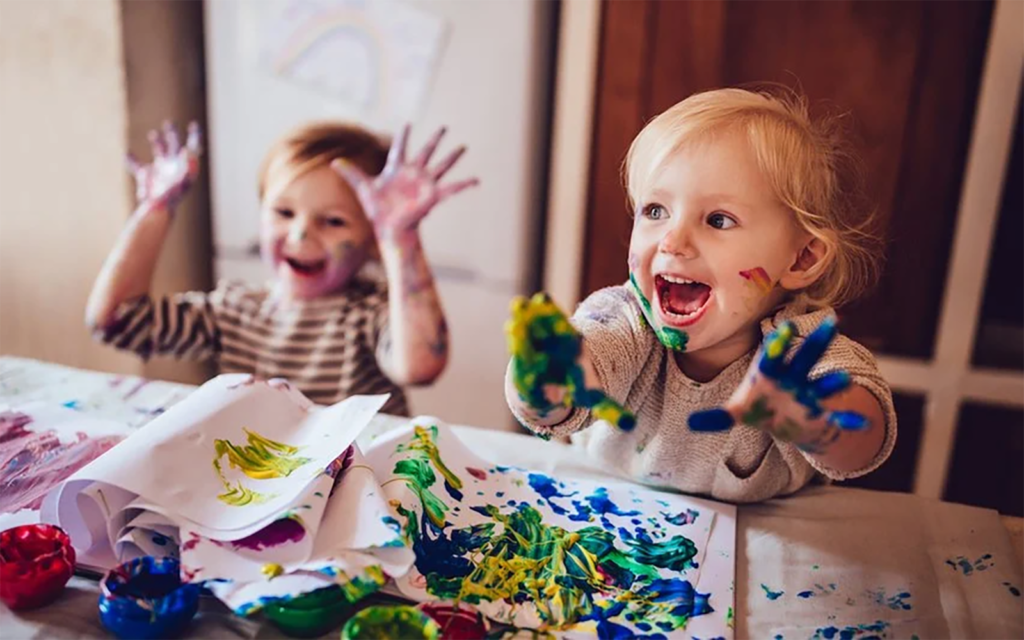
Promotes Body Awareness
Activities like scooping, pouring, or pinching materials from sensory bins, ideas for toddlers, promote fine and gross motor awareness. Every slight movement—grasping rice grains, pinching pom-poms, or squeezing slime—helps children improve their proprioceptive awareness.
Using a sensory bin table for toddlers, we can elevate these experiences by encouraging upright posture and spatial control. These tables are not just furniture; they are stations for movement integration.
In many of our global Montessori clients’ classrooms, easy sensory bins for toddlers are used daily to encourage coordination. Children pour from cup to cup, reinforcing wrist rotation and hand-eye coordination in a natural way.
Supports Learning and Language Development
Language development thrives when children are immersed in rich, engaging experiences, and sensory bins are full of those opportunities.
As children play, educators can introduce vocabulary like “rough,” “smooth,” “squishy,” “cold,” or “sticky.” Children not only hear these words but also experience them firsthand. This immediate, tactile association helps toddlers understand and retain new words more effectively.
We also see increased verbal expression during group sensory play. Children talk to peers about their actions—“I’m digging a tunnel,” or “Look, I found a rock!” These interactions build conversational skills, sentence structure, and narrative thinking.
In bilingual or second-language learning environments, sensory bins provide context-based language practice, which is far more effective than rote learning.

Fosters Motor Skills Development
Fine motor development is one of the most critical skills in early childhood. Children will struggle with pencil grip, scissors, buttoning clothes, and more without strong finger muscles and coordination. Sensory bins provide consistent, natural practice for these skills.
Sifting rice, picking up beads with tweezers, or scooping with spoons strengthens the small muscles in the hands and wrists. These are the same muscles required for handwriting and daily self-care routines.
Some sensory bins encourage larger arm movements for gross motor development, like pouring water or transferring larger items. You can even design standing sensory stations to encourage upright posture and full-body engagement.
The best part? Kids don’t even realize they’re working on muscle control—they’re simply enjoying themselves.

Receive a free catalog and custom layout to help you design your ideal classroom easily.
Aids Math Skills
Yes, you read that correctly—math. Sensory bins are an excellent foundation for early math concepts. When toddlers pour sand from a big cup into a small cup, they explore volume. When they count how many red beads they can find in a bin of multicolored ones, they develop number recognition and counting skills.
You can structure sensory activities to promote sorting, pattern recognition, and even basic addition and subtraction. For example, “How many blue buttons do we have?” or “Can you group all the smooth stones?”
Math surrounds us, and sensory bins make these abstract concepts tangible. This is especially helpful for visual and kinesthetic learners who may not grasp numbers from a worksheet but can master them with their hands.
Encourages Social Skills Development
Preschools are not just for academics—they’re also about helping toddlers navigate the social world. Sensory bins, especially in group settings, create ideal conditions for practicing those essential skills.
When two or three children share a bin, they must learn to take turns, negotiate tools, and sometimes cooperate to build a shared structure. This is real-time social learning in action.
Conflicts can arise—who gets the shovel first? But with guidance, children learn communication, patience, and empathy. These moments prepare them for more complex social situations in the future.
Mixed-age group play with sensory bins in Montessori environments also supports peer teaching. Older children often model appropriate behaviors and vocabulary for younger ones, reinforcing leadership and learning.
Supports Cognitive Development
Cognitive development is perhaps the most comprehensive benefit of sensory bins. Each sensory experience is also a problem to solve, a pattern to identify, or a story to imagine.
When a child decides to build a river with water and stones, they plan, experiment, and revise. This process involves memory, cause and effect, sequencing, and concentration.
This active engagement promotes executive function—mental skills that include working memory, flexible thinking, and self-control. These are the strongest predictors of school readiness and later academic success.

How to Make a Sensory Bin for Toddlers?
Creating sensory bins for toddlers might look simple, but a well-designed bin takes thoughtful planning. When done right, they become dynamic learning tools that support a child’s sensory, motor, cognitive, and emotional development.
Step 1: Choose a Sensory Bin Container
Before anything else, you need to choose the right sensory bin container. The container will shape how toddlers interact with the materials inside. It must be sturdy, shallow enough for children to reach in easily, and safe to use.
We recommend transparent, durable, and easy-to-clean containers. A sensory bin table for toddlers is ideal for schools. We often manufacture these purpose-built furniture items for early education clients. They allow several children to play simultaneously, with storage options and waist-level access for safety and comfort.
Avoid bins that are too deep, as toddlers may struggle to reach inside safely. Also, check for sharp edges or rough textures around the rim. Always prioritize child-safe, non-toxic materials.
Step 2: Pick a Theme
Now comes the creative part—choosing a theme. Themed sensory bins for toddlers are more than just cute decorations; they provide structure, context, and focused learning opportunities.
Pick a theme that aligns with your curriculum or seasonal activities. For example:
- An “Ocean Life” bin can include blue dyed rice, seashells, and toy sea creatures.
- A Christmas sensory bins for toddlers might use green-dyed pasta, mini ornaments, and pine-scented play-dough.
- Try a “Sorting and Counting” bin with color-coded beads and number cards for math development.
Themes should always be age-appropriate and safe. Avoid small items if your toddlers are still mouthing materials. Think about what you want the child to learn—language, sensory processing, social cooperation—and build a theme that targets those goals.
Remember, toddlers thrive on repetition. Rotating themes weekly or biweekly allows them to explore the materials while keeping play fresh and engaging.

Receive a free catalog and custom layout to help you design your ideal classroom easily.
Step 3: Choose Sensory Bin Fillers
Next, select the sensory bin fillers—the base material that covers most of the bin. This is the tactile foundation that makes a sensory bin work.
Common filler ideas include:
- Dry rice, pasta, beans, or oats
- Kinetic sand or play sand
- Shredded paper, fabric scraps, or water beads
- Cornmeal, flour, or potting soil (for themed bins like gardening)
When choosing fillers, always consider safety first. For younger toddlers, use large, non-chokable materials. You can also try homemade sensory bins for toddlers using colored rice dyed with food-safe coloring, or create a water-based bin with floating toys and waterproof tools.
Step 4: Add More Fun Tools and Objects
Finally, enrich your bin with engaging sensory bin tools for toddlers and small themed objects. These tools extend the learning potential of your bin and allow toddlers to practice fine motor skills, imaginative play, and problem-solving.
Must-have tools include:
- Scoops, funnels, cups, spoons
- Tongs, tweezers, or small shovels
- Water droppers or syringes (great for developing hand strength)
Try not to overload the bin—space is key. Provide enough items to spark interest, but allow the child to manipulate materials freely. This balance supports open-ended play and helps toddlers stay focused.

DIY Sensory Bins for Toddlers Ideas
Types of Sensory Bins for Toddlers explores various sensory bin setups, from dry to water-based, themed, seasonal, and tactile-focused options that support early childhood development.
Material-Based Sensory Bins
Cloud Dough
Cloud dough is a soft, moldable sensory material that feels like a cross between flour and play-dough. It’s dry yet holds its shape when pressed, making it perfect for scooping, molding, and imaginative play. This bin is ideal for quiet tactile exploration in both home and classroom settings.

Materials Needed:
- 8 cups of flour (or cornstarch for a gluten-free option)
- 1 cup of vegetable oil or baby oil
- Large bin or tray
- Optional: scoops, spoons, silicone molds, small toys (like animals or trucks), natural elements like leaves or pinecones
Benefits for Children:
- Tactile Sensory Input: Helps children explore texture, pressure, and temperature.
- Fine Motor Development: Scooping and molding improve hand strength and coordination.
- Imaginative Play: Children create pretend worlds or bakery scenes using molds and tools.
- Calming Effect: The soft, slow-moving nature of cloud dough can soothe overstimulated children.
- Language Development: Describing the texture and actions supports vocabulary growth.
Oobleck
Oobleck is a non-Newtonian fluid that acts like a solid when pressed and a liquid when left alone. It’s a fascinating sensory material that invites scientific curiosity and messy, hands-on exploration.

Materials Needed:
- 2 cups cornstarch
- 1 cup water
- Food coloring (optional)
- Large bin or tray
- Tools: spoons, toy animals, scoops
Benefits for Children:
- Tactile Exploration: Teaches resistance, pressure, and texture change in real time
- Science Learning: Introduces basic chemistry concepts through cause-and-effect play
- Motor Skill Practice: Stirring and grabbing engage hand muscles and coordination
- Language Development: Encourages use of descriptive words like “slippery,” “sticky,” or “hard.”
- Focus and Curiosity: Keeps toddlers engaged through open-ended, sensory-rich experiments
Water Beads
Water beads are smooth, squishy, and bouncy sensory materials that grow in water. They’re ideal for tactile exploration, scooping, and color-based sorting activities in toddler classrooms.

Materials Needed:
- Dried water beads (non-toxic, biodegradable options preferred)
- Water (to hydrate beads)
- Bin or container
- Scoops, colanders, funnels, measuring cups
Benefits for Children:
- Sensory Stimulation: Provides a cool, squishy texture that calms and excites simultaneously
- Color Recognition: Use multi-colored beads for sorting and matching games
- Fine Motor Skills: Picking up beads with fingers or tweezers strengthens coordination
- Scientific Thinking: Observing the beads expand over time introduces early science concepts
- Social Play: Encourages cooperative play when shared in a group setting
Soap Foam
Soap foam is a light, bubbly sensory material made from water and soap, often used for pretend cleaning or themed dramatic play. It’s visually stimulating and safe for young toddlers with supervision.

Materials Needed:
- 2 parts water
- 1 part tear-free baby soap or dish soap
- Hand mixer or blender
- Food coloring (optional)
- Bins, toys, scrub brushes, sponges
Benefits for Children:
- Sensory Input: Bubbly texture and scent stimulate touch and smell
- Pretend Play: Ideal for “cleaning” activities or imaginative scenes like a car wash or animal spa
- Hand Strengthening: Squeezing foam builds finger and hand strength
- Vocabulary Growth: Introduces action words like “scrub,” “wash,” “rinse,” and adjectives like “soapy” or “slippery”
- Emotional Regulation: Gentle textures can have a calming effect on overstimulated toddlers
Water
A simple water sensory bin offers endless learning potential. Water play is calming, open-ended, and adaptable to many themes—from floating science to pretend cooking or ocean scenes.

Materials Needed:
- Large waterproof bin or sensory bin table for toddlers
- Water (warm or room temperature)
- Toys: boats, cups, rubber ducks, sieves, plastic letters
- Optional: food coloring, ice, small waterproof figures
Benefits for Children:
- Motor Development: Pouring, filling, and splashing build gross and fine motor skills
- Science Exploration: Children learn about floating, sinking, temperature, and volume
- Language Skills: Offers opportunities to describe actions and materials
- Calming Sensory Play: Flowing water naturally soothes children and improves focus
- Thematic Versatility: Easily adapted for ocean bins, bath time pretend play, or seasonal weather bins
Gardening Soil
Gardening soil sensory bins bring nature indoors, allowing toddlers to dig, plant, and explore with their hands. This earthy setup encourages real-world connections to gardening and outdoor play.

Materials Needed:
- Potting soil (chemical-free and child-safe)
- Bin or tray
- Mini shovels, cups, scoops
- Toy vegetables, plastic bugs, fake flowers
- Optional: small pots, watering cans
Benefits for Children:
- Tactile Exploration: Rich, crumbly texture enhances fine sensory experiences
- Real-Life Skills: Simulates planting and gardening, teaching responsibility and care
- Language & Science: Introduces nature vocabulary—”root,” “soil,” “sprout”—and basic plant concepts
- Motor Skills: Digging and filling strengthen hands and coordination
- Imagination & Role Play: Encourages pretend gardening or bug-hunting adventures
Beads
Bead sensory bins offer vibrant, eye-catching materials perfect for sorting, counting, and fine motor development. They’re excellent for skill-building in math and coordination.

Materials Needed:
- Plastic or wooden beads (large, non-chokable)
- Bowls, cups, muffin tins
- Tongs, spoons, scoops
- Optional: number cards, color-matching mats
Benefits for Children:
- Color & Pattern Recognition: Supports early math concepts and cognitive sorting
- Fine Motor Precision: Picking up small beads with tools or fingers strengthens hand muscles
- Counting Practice: Beads can be grouped for simple addition or subtraction tasks
- Language Skills: Describing shapes, colors, and patterns enhances vocabulary
- Visual Stimulation: Bright beads hold children’s attention and increase focus
Cornmeal
Cornmeal is a soft, grainy filler perfect for sensory bins designed to mimic sand or soil. It’s a budget-friendly, natural material with a soothing texture ideal for scooping and pouring.

Materials Needed:
- Corn meal (dry, non-flavored)
- Bin or tray
- Scoops, cups, funnels
- Optional: toy farm animals, diggers, natural items like leaves or sticks
Benefits for Children:
- Textural Exploration: The fine grit supports gentle sensory input
- Motor Skills: Pouring and scooping promote hand-eye coordination
- Pretend Play: Cornmeal resembles natural environments for farms or construction sites
- Language Development: Great for describing soft, gritty, dusty, or powdery textures
- Quiet Focus Time: Natural textures can reduce overstimulation in busy classrooms
Sand
Sand is a timeless sensory material that supports digging, shaping, and imaginative play. Whether dry or dampened, it provides hands-on learning in both indoor and outdoor bins.

Materials Needed:
- Play-grade sand (clean and dust-free)
- Large bin or sensory table
- Shovels, molds, cups, toy tools
- Optional: shells, rocks, toy dinosaurs, mini construction vehicles
Benefits for Children:
- Tactile Sensory Input: Grainy texture supports sensory regulation
- Imaginative Scenarios: Great for beach themes, fossil digs, or construction sites
- Fine Motor Development: Scooping and molding encourage hand strength and control
- Spatial Awareness: Kids learn about depth, volume, and size through container play
- Cognitive Development: Experimenting with wet vs. dry sand introduces scientific thinking
Dry Pasta
Dry pasta bins are colorful, noisy, and endlessly versatile. Available in different shapes and sizes, pasta is ideal for toddlers learning sorting, counting, and texture-based play.

Materials Needed:
- Uncooked pasta (e.g., penne, bowtie, macaroni)
- Food coloring (optional for rainbow pasta)
- Measuring cups, scoops, muffin tins
- Small bowls, tongs, jars
Benefits for Children:
- Sensory Exploration: Hard, dry texture is stimulating and distinct
- Color & Shape Recognition: Pasta comes in various forms, ideal for sorting games
- Fine Motor Control: Picking up and pouring strengthens wrist and finger function
- Math Readiness: Supports one-to-one correspondence and counting
- Creative Play: Toddlers use pasta to “cook,” build, or pretend shop
Dry Beans
Dry beans are a staple in a low-cost sensory bin for toddlers. Their smooth surface and weight make them ideal for scooping, pouring, and sorting activities.

Materials Needed:
- Dried beans (pinto, black, white, lentils)
- Measuring cups, spoons, scoops
- Toy vegetables, bugs, or small farm animals
- Optional: funnels, jars, tweezers
Benefits for Children:
- Tactile Engagement: Smooth, cool texture is calming and satisfying to touch
- Motor Coordination: Pouring and scooping practice supports hand control
- Sensory Feedback: Weighted materials enhance proprioceptive learning
- Math Skills: Use for counting, sorting by size/color, or measuring games
- Thematic Play: Pairs well with farm, harvest, or cooking bin setups
Dry Rice
Dry rice is one of the most versatile and accessible fillers for sensory bins for toddlers. Lightweight and flowing, it provides a satisfying tactile experience that encourages endless scooping, pouring, and exploration.

Materials Needed:
- Uncooked white rice
- Large bin or tray
- Measuring cups, spoons, and funnels
- Optional: colored rice (using food coloring + vinegar), small toys or objects
Benefits for Children:
- Tactile Stimulation: Flowing texture supports finger dexterity and sensory input
- Motor Skills: Pouring and scooping help develop hand-eye coordination
- Thematic Flexibility: Easily dyed to match holiday or academic themes
- Cognitive Growth: Encourages sorting, filling, and early science observation
- Language Use: Promotes vocabulary through describing textures and play actions
Magic Mud
Magic mud is a thick, cool, and pliable material made from starch and water. It has a unique texture—firm under pressure, liquid when left alone—that’s perfect for open-ended sensory discovery.

Materials Needed:
- Cornstarch or potato starch
- Water (adjust ratio for texture)
- Large bin or sensory tray
- Optional: food coloring, droppers, small toys
Benefits for Children:
- Sensory Curiosity: Offers unexpected, changing textures that fascinate toddlers
- Early Science: Demonstrates non-Newtonian properties, encouraging inquiry
- Motor Control: Scooping, pressing, and squishing strengthen muscles
- Mindfulness: Engaging with the texture can calm anxious or hyper children
- Language Development: Promotes expressive words like “melty,” “firm,” or “gooey.”
Shredded Paper
Shredded paper is a lightweight, safe, and eco-friendly sensory filler ideal for hiding, digging, and pretend play. It’s great for indoor bins where cleanup and safety are top priorities.

Materials Needed:
- Shredded office or craft paper (non-glossy, ink-free preferred)
- Tray or medium bin
- Optional: scoops, animal figurines, plastic eggs, tweezers
Rainbow Rice
Rainbow rice is dry rice dyed in vivid colors to stimulate visual interest and support color-based learning activities. It’s perfect for sorting, scooping, and theme-based bins.

Materials Needed:
- Uncooked rice
- Food coloring
- Vinegar or rubbing alcohol (to set color)
- Zip bags for dyeing, plus a large bin
- Tools: scoops, cups, toy objects
Benefits for Children:
- Color Recognition: Reinforces basic colors through hands-on sorting
- Visual Stimulation: High contrast draws attention and promotes focus
- Motor Skill Building: Pouring and measuring strengthen fine motor control
- Language Expansion: Encourages descriptive and comparative speech
- Open-Ended Play: Easily adapted to holidays, emotions, or math themes
Academic & Skill-Based Sensory Bins
Alphabet and Play-Dough
This sensory bin blends alphabet learning with playdough to create a hands-on literacy experience. Children explore letter shapes through stamping, molding, and tracing, all while strengthening motor skills.

Materials Needed:
- Non-toxic playdough
- Plastic letter stamps or alphabet cutters
- Laminated letter cards
- Small bin or tray
- Optional: dry pasta letters, small tools like rolling pins
Benefits for Children:
- Letter Recognition: Reinforces letter shapes through tactile interaction
- Motor Skills: Rolling, pressing, and molding strengthen writing muscles
- Phonics Foundations: Children connect letter sounds to their physical forms
- Focus and Creativity: Open-ended activity that keeps toddlers engaged
- Language Building: Encourages name spelling, word formation, and phonetic discussion
Numbers and Counting
This bin focuses on early math skills through fun, interactive counting activities. Toddlers match numbers with quantities and practice grouping, sorting, and recognizing numerical order.

Materials Needed:
- Number cards (1–10 or 1–20)
- Counters (pom-poms, toy animals, buttons)
- Bowls, scoops, muffin tins
- Tweezers or tongs
- Optional: egg cartons, felt ten frames
Benefits for Children:
- Numeracy Development: Builds foundational skills in counting and number matching
- Visual Learning: Helps link symbols (numbers) with real quantities
- Fine Motor Strength: Picking up small counters supports finger control
- Math Language: Encourages use of terms like “more,” “fewer,” “equal”
- Sorting & Classifying: Enhances cognitive processing and problem-solving
“Name” Sensory Bin
This bin supports early literacy by helping toddlers recognize and spell their names. Children search for and arrange the letters of their name using engaging sensory materials.

Materials Needed:
- Fillers: dry rice, paper shreds, or pasta
- Foam or magnetic letters
- Name cards (first name in capital and lowercase)
- Tweezers, scoops
- Optional: laminated letter mats
Benefits for Children:
- Name Recognition: Reinforces personal identity and self-awareness
- Letter Sequencing: Supports spelling and early word formation
- Fine Motor Practice: Grabbing and placing letters enhances hand control
- Confidence Building: Toddlers take pride in identifying and spelling their name
- Language Skills: Encourages phonetic awareness and alphabet familiarity
Muffin Math
This playful math-themed bin uses a muffin tin as a sorting and counting tool. Children place the correct number of items in each cup, promoting number recognition and one-to-one correspondence.

Materials Needed:
- Muffin tin (6 or 12 cups)
- Number cards or dots (1–12)
- Counters: pom-poms, buttons, beads
- Tongs or spoons
- Optional: themed items (e.g., mini erasers, fruit toys)
Benefits for Children:
- Counting & Matching: Reinforces early math through concrete quantity work
- Visual-Spatial Skills: Helps toddlers organize objects within a defined space
- Motor Coordination: Picking and placing items builds fine motor ability
- Independent Practice: Simple structure allows for solo or group learning
- Engagement: A Familiar kitchen item adds novelty and fun
Seasonal & Holiday-Themed Sensory Bins
Fall Sensory Bin
Celebrate the autumn season with a sensory bin inspired by nature’s textures and colors. This bin uses fall-themed materials to spark exploration, conversation, and seasonal awareness.

Materials Needed:
- Fillers: dry corn, leaves, shredded paper, lentils
- Fall items: acorns, mini pumpkins, pinecones
- Scoops, tweezers, and small buckets
- Optional: laminated fall vocabulary cards
Benefits for Children:
- Seasonal Awareness: Connects children to weather, nature, and cultural shifts
- Tactile Play: Crunchy, varied textures enhance sensory learning
- Language Expansion: Introduces fall-themed vocabulary like “harvest,” “leaf,” or “acorn.”
- Motor Skill Development: Grabbing and sorting promote hand-eye coordination
- Thematic Exploration: Supports classroom discussions about fall traditions and changes
Spring Sensory Bin
This spring-themed bin celebrates growth, renewal, and color. Using flower-inspired fillers and garden objects, toddlers explore new textures while learning about the season’s changes.

Materials Needed:
- Green rice, flower petals (real or fabric), dry beans
- Toy bugs, plastic flowers, mini watering cans
- Scoops, spoons, and small shovels
- Optional: spring-themed word cards
Benefits for Children:
- Nature Connection: Reinforces the concept of growth and seasonal transformation
- Color Recognition: Bright visuals stimulate curiosity and color sorting
- Tactile Learning: Mixing soft, smooth, and light textures supports sensory development
- Imaginative Play: Encourages gardening role-play and nature storytelling
- Language Enrichment: Introduces spring-related terms like “bloom,” “seed,” or “bud.”
Easter Sensory Bin
This Easter-themed sensory bin is colorful, calming, and full of discovery. It encourages toddlers to explore seasonal symbols like eggs, bunnies, and springtime textures through tactile play.

Materials Needed:
- Fillers: green shredded paper, colored rice, dry lentils
- Plastic eggs, mini bunnies or chicks
- Scoops, egg cartons, tongs
- Optional: Easter-themed number/letter cards
Benefits for Children:
- Fine Motor Practice: Opening eggs, pinching small toys, and building finger strength
- Color Sorting: Bright spring colors encourage visual discrimination and categorizing
- Seasonal Vocabulary: Introduces words like “egg,” “hatch,” “bunny,” and “basket.”
- Counting Skills: Use eggs and beans for simple quantity games
- Imaginative Play: Supports pretend Easter egg hunts or storytelling activities
Halloween Sensory Bin
Halloween sensory bins mix spooky fun with sensory development. Using dark colors and themed objects, toddlers explore textures while engaging in safe, seasonal play.

Materials Needed:
- Fillers: black beans, orange rice, purple pom-poms
- Halloween items: mini pumpkins, plastic spiders, ghosts, bats
- Tools: tweezers, tongs, scoops
- Optional: glow-in-the-dark pieces, flashlight for dark room play
Benefits for Children:
- Tactile Input: Encourages exploration of creepy, squishy, and smooth textures
- Thematic Learning: Connects to holiday traditions in a hands-on way
- Language Skills: Promotes vocabulary like “spider,” “ghost,” “witch,” and “scary”
- Cognitive Play: Sorting by size, color, or type enhances classification skills
- Bravery & Imagination: Gives toddlers a chance to engage with spooky symbols in a non-threatening context
Christmas Sensory Bins
This Christmas sensory bin brings holiday cheer into the classroom through texture, color, and seasonal symbols. It’s ideal for combining festive spirit with educational benefits.

Materials Needed:
- Fillers: red and green rice, cotton balls (snow), jingle bells
- Christmas items: mini ornaments, pinecones, toy trees
- Tools: scoops, spoons, small containers
- Optional: laminated Christmas vocabulary cards
Benefits for Children:
- Seasonal Excitement: Builds anticipation and familiarity with Christmas themes
- Sensory Engagement: Variety of textures—soft, bumpy, metallic—enhances tactile play
- Fine Motor Control: Picking up small items and scooping strengthens fingers
- Language Growth: Introduces terms like “Santa,” “snow,” “bell,” “tree,” and “gift.”
- Math Opportunities: Count ornaments, sort by color or shape for early numeracy
Valentine Sensory Bin
This Valentine-themed sensory bin is filled with soft textures, heart shapes, and red-pink tones to create a calming, love-filled sensory experience. It’s ideal for gentle, focused play in February.

Materials Needed:
- Fillers: red rice, pink lentils, shredded paper, cotton balls
- Heart-shaped containers, plastic roses, mini envelopes
- Scoops, tweezers, spoons
- Optional: alphabet beads or letter tiles for name and word building
Benefits for Children:
- Fine Motor Development: Using tongs and tweezers strengthens small hand muscles
- Color Recognition: Focus on red, pink, and white tones for visual learning
- Emotional Learning: Encourages discussion about love, friendship, and kindness
- Literacy Links: Use letters to spell words like “love,” “hug,” or names
- Sensory Soothing: Soft materials promote calm, quiet engagement
St Patrick’s Day Sensory Bins
Celebrate March with a green-and-gold St. Patrick’s Day sensory bin, inviting toddlers to explore textures while hunting for shamrocks, coins, and “leprechaun treasure.”

Materials Needed:
- Fillers: green rice, green split peas, gold pasta, shredded green paper
- Plastic coins, shamrocks, rainbows, mini pots
- Scoops, tongs, trays
- Optional: laminated counting cards or color sorting mats
Benefits for Children:
- Tactile Play: Diverse textures like smooth coins and grainy peas support sensory development
- Math Exploration: Great for counting, sorting, and matching by color or object
- Thematic Learning: Introduces symbols like “rainbow,” “gold,” and “luck.”
- Cultural Awareness: Opens a conversation about holiday traditions and Irish themes
- Imaginative Thinking: Encourages pretend treasure hunts and leprechaun stories
Nature & Science-Themed Sensory Bins
Dinosaur Volcano
This dramatic dinosaur-themed bin adds excitement with a mini volcano setup. Toddlers explore prehistoric play through textures, role-play, and sensory discovery.

Materials Needed:
- Fillers: kinetic sand, pebbles, dry soil, red rice
- Plastic dinosaurs, volcano model (baking soda + vinegar for eruption)
- Spoons, brushes, rocks
- Optional: dinosaur footprint cards
Benefits for Children:
- Imaginative Play: Supports storytelling and dramatic scenes
- Science Concepts: Introduces ideas of eruption, fossils, and earth layers
- Sensory Experience: Rough textures build tactile awareness
- Fine Motor Practice: Digging and scooping improve precision
- Vocabulary Growth: Teaches words like “lava,” “fossil,” “erupt,” and “dinosaur.”
Butterfly
This gentle, nature-based bin introduces toddlers to butterflies and the life cycle. It combines soft textures and vibrant colors for sensory-rich learning.

Materials Needed:
- Fillers: green paper shreds, flower petals, colored rice
- Butterfly figurines, caterpillar models, silk flowers
- Scoops, tongs, and life cycle cards
- Optional: magnifying glass
Benefits for Children:
- Life Cycle Learning: Helps visualize metamorphosis stages
- Tactile Play: Combines soft and smooth materials for exploration
- Color Recognition: Bright visuals support sorting and identification
- Fine Motor Development: Picking up tiny butterflies improves control
- Language Expansion: Introduces terms like “chrysalis,” “wings,” and “flutter.”
Space Sensory Bin
Blast off into outer space with this cosmic sensory bin. Children explore stars, planets, and textures from “beyond Earth” in a play-based learning experience.

Materials Needed:
- Fillers: black beans, dark blue rice, silver glitter
- Planet balls, astronaut figures, stars, moon rocks
- Scoops, tweezers, and space flashcards
- Optional: glow-in-the-dark items
Benefits for Children:
- STEM Concepts: Introduces space, gravity, and astronomy basics
- Sensory Engagement: Smooth, cool textures promote calming tactile play
- Visual Learning: Contrast colors strengthen attention and observation
- Vocabulary Building: Words like “planet,” “orbit,” “astronaut,” and “rocket”
- Creative Imagination: Supports storytelling and pretend missions
Ocean Sensory Bin
Dive into ocean life with a sensory bin filled with sea creatures and aquatic textures. It supports science learning and sensory exploration all in one.

Materials Needed:
- Fillers: blue dyed rice, water beads, shells, sand
- Toy fish, sharks, whales, and boats
- Scoops, cups, nets
- Optional: laminated ocean animal cards
Benefits for Children:
- Nature Exploration: Teaches about marine life and ecosystems
- Sensory Variety: Wet/dry contrast enhances tactile experience
- Sorting & Classifying: Organize sea animals by size or type
- Language Skills: Vocabulary includes “ocean,” “wave,” “fish,” and “shell.”
- Imaginative Play: Encourages pretend underwater scenes
Weather Sensory Bin
This weather-themed bin introduces children to natural elements like rain, clouds, and sunshine through hands-on play and visual cues.

Materials Needed:
- Fillers: cotton balls (clouds), blue gems or rice (rain), yellow felt (sun)
- Umbrellas, thermometers, weather icons
- Tongs, scoops
- Optional: daily weather cards
Benefits for Children:
- Weather Awareness: Teaches concepts like hot, cold, rainy, sunny
- Sensory Exploration: Soft, smooth, and cold textures encourage discovery
- Fine Motor Skills: Grasping and sorting small items strengthen hands
- Science Vocabulary: Includes “forecast,” “storm,” “sunshine,” and “temperature”.
- Cognitive Links: Supports sequencing (e.g., rain before rainbow)
On the Farm
This farm-themed sensory bin introduces toddlers to animals, crops, and tools found on a farm. It builds real-world understanding through texture and role-play.

Materials Needed:
- Fillers: corn kernels, hay (paper or raffia), soil or beans
- Toy animals (cow, pig, chicken), tractors, barns
- Scoops, rakes, cups
- Optional: animal sound cards
Benefits for Children:
- Life Skills: Teaches where food comes from and daily farm life
- Sensory Input: Crunchy, earthy textures stimulate tactile learning
- Language & Sound Recognition: “Oink,” “moo,” “cluck” support early sound play
- Imaginative Play: Toddlers act out farm chores and routines
- Sorting & Classification: Group by animal type or habitat
Fire Station Sensory Bin
This high-interest sensory bin puts toddlers in the role of firefighters. Through dramatic play and rescue-themed tools, children explore bravery, safety, and emergency response in an engaging way.

Materials Needed:
- Fillers: red rice, black beans, cotton balls (for “smoke”)
- Toy fire trucks, firefighters, ladders, flames (felt or plastic)
- Scoops, hoses (straws), mini buildings
- Optional: firefighter helmets or badges
Benefits for Children:
- Dramatic Play: Encourages storytelling and role-playing emergency scenarios
- Community Awareness: Teaches the role of firefighters and fire safety
- Motor Skills: Use of tweezers and tools improves hand control
- Emotional Intelligence: Builds empathy and teamwork through rescue play
- Language Growth: Learn words like “hose,” “rescue,” “fire,” and “alarm.”
Creative & Story-Based Sensory Bins
Ice Cream
This sweet sensory bin brings the ice cream shop to life with soft textures, scooping tools, and color-matching activities that toddlers love.

Materials Needed:
- Fillers: pom-poms, kinetic sand, cotton balls (in “flavor” colors)
- Ice cream scoops, cones, bowls
- Tongs, measuring spoons
- Optional: menu cards or color-coded orders
Benefits for Children:
- Pretend Play: Encourages role-play as a shopkeeper or a customer
- Color Recognition: Match scoops to orders by color or number
- Fine Motor Skills: Scooping and transferring strengthen grip and control
- Language Growth: Vocabulary like “scoop,” “flavor,” “cone,” “cold”
- Math Concepts: Count scoops, build “ice cream stacks” by size or order
Tropical Summer
The Tropical Summer sensory bin is full of sunshine, ocean elements, and fruity textures. It brings warmth and seasonal excitement to sensory playtime.

Materials Needed:
- Fillers: yellow rice, dried coconut flakes, green shredded paper
- Plastic pineapples, palm trees, flamingos
- Scoops, shells, sunglasses, props
- Optional: tropical drink cups, themed word cards
Benefits for Children:
- Seasonal Awareness: Teaches summer-related words and weather symbols
- Visual Stimulation: Bright colors support attention and engagement
- Sensory Play: Tropical textures encourage full-hand exploration
- Role-Playing: Supports beach scenes, vacation stories, or fruit stand setups
- Language Learning: New terms like “tropical,” “island,” “fruit,” and “sun”
Lemonade Stand
This cheerful bin invites children to build and run their own lemonade stand. It mixes math, sorting, and pretend play in a hands-on, multisensory setup.

Materials Needed:
- Fillers: yellow rice or dried lemon slices
- Toy lemons, cups, pitchers, and coins
- Scoops, measuring spoons, funnels
- Optional: printable “menu” or order cards
Benefits for Children:
- Counting & Money Concepts: Use pretend coins for purchasing and change
- Math Readiness: Pouring and measuring supports volume awareness
- Business Vocabulary: Learn “price,” “cup,” “order,” and “lemon.”
- Motor Skills: Squeezing tools and scooping motions build hand strength
- Creative Thinking: Encourages entrepreneurial role-play
DIY “Gravel Pit”
This construction-inspired sensory bin gives toddlers the chance to build, dig, and haul using gritty textures and toy trucks. It’s a favorite for children who love machines and movement.

Materials Needed:
- Fillers: dry beans, gravel-textured rice, small pebbles
- Toy construction vehicles (dump trucks, loaders)
- Mini road signs, cones, and rocks
- Shovels, cups, scoops
Benefits for Children:
- Motor Skills: Digging and scooping develop hand-eye coordination
- STEM Learning: Introduces machinery functions and basic construction terms
- Sensory Input: Coarse materials stimulate tactile processing
- Imaginative Play: Role-play construction jobs, road building, and deliveries
- Problem Solving: Moving materials around encourages planning and task completion
Earl The Squirrel: Book and Bin
Inspired by the picture book Earl the Squirrel by Don Freeman, this sensory bin connects literacy and play by bringing the story to life through hands-on materials.

Materials Needed:
- Fillers: brown rice, shredded paper, small acorns
- Toy squirrels, red scarves, tiny trees
- Scoops, tweezers, and magnifying glasses
- Optional: a copy of the book and character cards
Benefits for Children:
- Literacy Integration: Reinforces story comprehension and sequencing
- Nature Concepts: Connects animals and forest life with classroom learning
- Emotional Connection: Helps toddlers relate to characters and events
- Fine Motor Skills: Picking up acorns and small objects improves control
- Vocabulary Practice: Uses story terms like “scarf,” “tree,” “squirrel,” and “nut.”
Supermarket Sensory Bin
Turn the sensory table into a mini grocery store. This bin introduces sorting, money, and food groups while supporting dramatic play and early math skills.
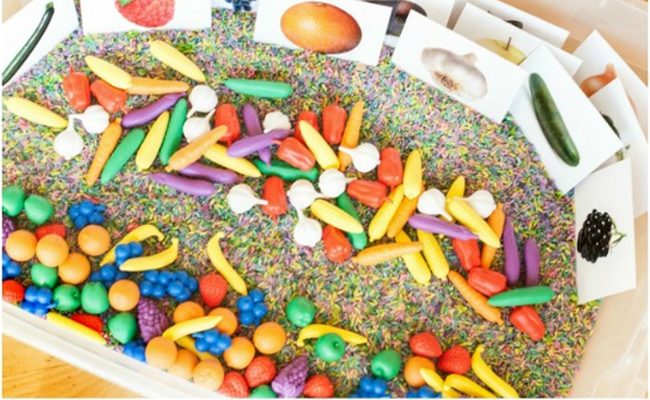
Materials Needed:
- Fillers: dry pasta or rice
- Mini food toys (fruits, veggies, cans), baskets, shopping bags
- Plastic coins, receipts, cash register toy
- Optional: food category cards or shopping lists
Benefits for Children:
- Sorting & Categorizing: Learn food groups, colors, and sizes
- Math Practice: Use pretend money for basic counting and exchanging
- Role Play: Act as a cashier or a shopper to build communication and social skills
- Vocabulary Development: Terms like “buy,” “pay,” “fruit,” and “cart”
- Fine Motor Skills: Picking up and placing items encourages control and planning
Moon and Stars Sensory Bin
Bring nighttime wonder into the classroom with a moon-and-stars-themed bin. Toddlers explore space, darkness, and light using calming, celestial-themed materials.

Materials Needed:
- Fillers: black beans, blue rice, silver glitter
- Glow-in-the-dark stars, moon rocks (painted stones), astronauts
- Flashlights, scoops, and magnifying glasses
- Optional: night sky chart or space-themed book
Benefits for Children:
- Science Exploration: Introduces night, stars, and moon phases
- Sensory Play: A Mix of shiny, smooth, and cool textures promotes engagement
- Language Development: Use words like “glow,” “twinkle,” “orbit,” and “sky.”
- Calming Atmosphere: Soothing visuals and quiet play encourage focus
- Imagination: Toddlers pretend to be stargazers or astronauts
Sound & Texture Sensory Bin
Let toddlers explore sound and touch at the same time through an engaging mix of noisy, bumpy, and crinkly materials. This bin is perfect for sensory seekers who respond well to auditory feedback and enjoy active experimentation. It creates a stimulating environment that invites curiosity, movement, and active language use.

Materials Needed:
- Fillers: dried pasta, rice, bells, crinkly cellophane
- Containers with lids, scoops, egg shakers
- Mini drums or noise-makers
- Optional: headphones or a quiet corner for contrast
Benefits for Children:
- Auditory Development: Supports sound discrimination and attention
- Fine Motor Skills: Filling and shaking containers builds control
- Sensory Integration: Combines auditory and tactile stimulation
- Language: Words like “loud,” “soft,” “crinkle,” “shake,” “buzz”
- Exploration: Encourages cause-effect learning and experimentation
Fruit Market Sensory Bin
Simulate a colorful fruit stand where toddlers can shop, sort, and count using play food and scooping tools. This bin mirrors real-world routines while introducing colors, names of fruits, and simple math concepts. It’s a cheerful and interactive sensory experience that combines play with practical life learning.

Materials Needed:
- Fillers: dried lentils or chickpeas
- Toy fruits (foam, felt, or plastic), mini baskets
- Toy cash register or price tags
- Optional: shopping bag, play money, scale
Benefits for Children:
- Real-Life Connections: Teaches shopping and sorting behavior
- Math Skills: Begin to understand weight, counting, and comparison
- Vocabulary: Fruit names, colors, size, and descriptive language
- Fine Motor: Picking and placing fruits builds coordination
- Imaginative Play: Supports role-switching (shopkeeper vs customer)
Shapes & Shadows Sensory Bin
Create a visually stimulating bin where toddlers explore basic shapes and their shadows using light and tactile props. This bin introduces early geometry and simple physics in a playful, age-appropriate way. Children can match, trace, and describe shapes while learning how light creates shadows.

Materials Needed:
- Fillers: black beans or dark felt
- Wooden or foam shapes (triangles, circles, squares)
- Flashlight, silhouette cards
- Clear bin or transparent base
Benefits for Children:
- Early Geometry: Identifying, naming, and comparing basic shapes
- Science Discovery: Learn how light and shadows interact
- Problem-Solving: Match shapes to outlines or silhouettes
- Language Development: Terms like “circle,” “angle,” “shadow,” “light”
- Focused Attention: Quiet, calming activity that requires observation
Toolbox Sensory Bin
Let toddlers tinker like little builders with tools, bolts, and nuts in a safe and creative sensory environment. This bin supports spatial reasoning, sequencing, and hand strength while encouraging imaginative mechanical play. Perfect for toddlers who love to figure out how things work and enjoy hands-on manipulation.

Materials Needed:
- Fillers: dried black beans or shredded foam
- Plastic or wooden tools (hammer, wrench, screwdriver)
- Nuts, bolts, washers (oversized and toddler-safe)
- Optional: toy screws with holes or foam “wood” pieces
Benefits for Children:
- STEM Thinking: Introduces basic construction and mechanical problem-solving
- Fine Motor Precision: Turning, twisting, and pushing build hand strength
- Vocabulary: Teach tool names and action verbs like “twist,” “build,” “tighten,” “loosen”
- Role Play: Toddlers act as builders, engineers, or repair people
- Focus & Patience: Engaging tasks encourage persistence and concentration
Space Rocket Launch Bin
Let toddlers simulate their own rocket launch with dramatic textures and shiny materials inspired by space travel. This bin introduces basic space concepts and invites open-ended, imaginative play with astronaut figures and “moon dust.” It also encourages exploration of gravity, lift-off, and space-themed vocabulary in a hands-on setting.

Materials Needed:
- Fillers: silver kinetic sand or flour + glitter mix
- Toy rockets, astronaut figures, foam planets
- Small scoops, launch pad made from blocks
- Optional: star chart or planet flashcards
Benefits for Children:
- STEM Introduction: Simple concepts like launch, orbit, and gravity
- Imaginative Play: Toddlers act out space missions and landings
- Tactile Development: Moldable fillers engage fine motor planning
- Language Growth: Words like “blast off,” “planet,” “orbit,” and “moon”
- Curiosity: Encourages questions about space and science
Texture Trail Sensory Bin
Design a path of textures for little hands and fingers to explore, using varied, layered materials. This bin is perfect for sensory-sensitive children who benefit from controlled, repeated exposure to different tactile inputs. It also supports descriptive language, emotional regulation, and personal sensory discovery.

Materials Needed:
- Fillers: felt pieces, bubble wrap, sandpaper, satin fabric, rubber mats
- Small animal figurines to “walk” along the trail
- Optional: blindfold for touch-only exploration
Benefits for Children:
- Sensory Regulation: Encourages exploration in a non-threatening way
- Language Development: Use words like “rough,” “soft,” “smooth,” “bumpy”
- Fine Motor Awareness: Touching, stroking, and pressing help refine control
- Self-Awareness: Children learn to identify textures they like or dislike
- Focus: Encourages slow, mindful play and sensory mindfulness
Musical Instruments Bin
Bring sound, rhythm, and motion into the sensory table with toddler-safe musical tools and sound-making fillers. This bin supports auditory processing and rhythm recognition while inviting creativity and musical expression. It’s ideal for group settings and helps toddlers develop listening, timing, and cooperative play skills.

Materials Needed:
- Fillers: dry pasta, bells, small shaker pods
- Toy drums, tambourines, castanets
- Wooden sticks or beaters
- Optional: musical note cards or song lyrics
Benefits for Children:
- Auditory Development: Exposure to various sound sources and rhythms
- Gross Motor Control: Banging, tapping, and shaking refine coordination
- Group Play: Encourages listening, turn-taking, and collaboration
- Self-Expression: Allows toddlers to explore sound through movement
- Language: Terms like “beat,” “loud,” “quiet,” and “shake”
Transportation Sensory Bin
A high-energy bin where toddlers dig through filler to discover and organize toy vehicles by type or function. It creates a fun space to explore motion, movement, and early sorting, all while engaging fine motor actions. Children can set up roads, parking lots, or obstacle courses to enhance spatial awareness and storytelling.

Materials Needed:
- Fillers: black beans or fine gravel
- Toy cars, buses, airplanes, boats
- Road tape or foam blocks to build paths
- Optional: traffic signs or sorting labels
Benefits for Children:
- STEM Concepts: Vehicle types, motion, direction, and speed
- Sorting & Classification: Organize vehicles by land, air, or sea
- Language: Learn terms like “drive,” “fly,” “stop,” “go,” “crash”
- Pretend Play: Children narrate transport scenarios or build cities
- Motor Planning: Maneuvering objects along defined paths
Jungle Safari Sensory Bin
Let toddlers journey into the jungle with leafy textures, camouflaged animals, and nature-inspired props. They can discover, name, and role-play with wild animals while building vocabulary and sensory confidence. This bin promotes storytelling, tactile exploration, and environmental awareness in a calm, green-toned setting.

Materials Needed:
- Fillers: shredded green paper, moss, leaves (real or felt)
- Jungle animals (tiger, monkey, snake, elephant, parrot)
- Magnifying glass, binoculars, baskets
- Optional: jungle sounds playlist or animal photo cards
Benefits for Children:
- Language Growth: Animal names, sounds, and habitat vocabulary
- Sensory Exploration: Nature textures support touch and curiosity
- Role-Play: Toddlers imagine life in a wild environment
- Auditory Input: Pairing with jungle sounds enhances immersion
- Observation Skills: Encourages close looking and description
Laundry Day Sensory Bin
Recreate a real-life chore in sensory play form where toddlers sort, fold, and “wash” tiny laundry items. This bin builds practical life skills while strengthening fine motor coordination and early categorization. It also provides an excellent opportunity for language development around clothing and daily routines.

Materials Needed:
- Fillers: cotton balls or white rice (as “soap”)
- Doll clothes, socks, mini clothespins
- Toy washing machine, clothesline or drying rack
- Optional: laundry basket, small spray bottle
Benefits for Children:
- Life Skills: Introduces cleaning, sorting, and folding behaviors
- Fine Motor Practice: Pinching, hanging, and matching support coordination
- Vocabulary: Words like “clean,” “dirty,” “sock,” “shirt,” “fold,” “dry”
- Routine Awareness: Familiarizes toddlers with everyday home tasks
- Sorting & Matching: Encourages categorizing by color, size, or type
Types of Sensory Bins for Toddlers
Clear-View Sand and Water Tray Table
This transparent, acrylic-based sensory bin is ideal for visual learners. Its clear tray allows children to see materials from multiple angles and observe reactions between elements such as water and sand.
Key Features and Benefits:
- Compact Design: Ideal for small classrooms or group-focused stations.
This model encourages observational skills and supports early science learning through visual engagement. - Visibility: Teachers can easily monitor interactions and group dynamics.
- Scientific Exploration: Children observe sinking, floating, and color changes in real time.

Mobile Sand & Water Table with Top
Designed for versatility, this mobile table comes with locking wheels and a protective top, making it easy to store and move between classrooms or indoor/outdoor settings.
Key Features and Benefits:
- Mobility: Perfect for schools needing to rearrange space frequently.
- Protective Cover: Keeps materials clean and secure when not in use.
- Dual-Use Compartments: Allows simultaneous wet and dry sensory activities.
This model supports flexible scheduling and quick transitions—ideal for busy preschool programs.

Mobile Sensory Play Kitchen
Combining dramatic play with tactile engagement, the mobile sensory play kitchen encourages role-playing and real-world scenario building. It includes sinks, pretend stovetops, and storage compartments.
Key Features and Benefits:
- Multi-Sensory Play: Encourages the integration of smell, touch, and imagination.
- Social Development: Promotes cooperative play and communication.
- Cognitive Growth: Supports sequencing and role-based storytelling.
This setup merges sensory and dramatic play, making it a multifunctional classroom asset.
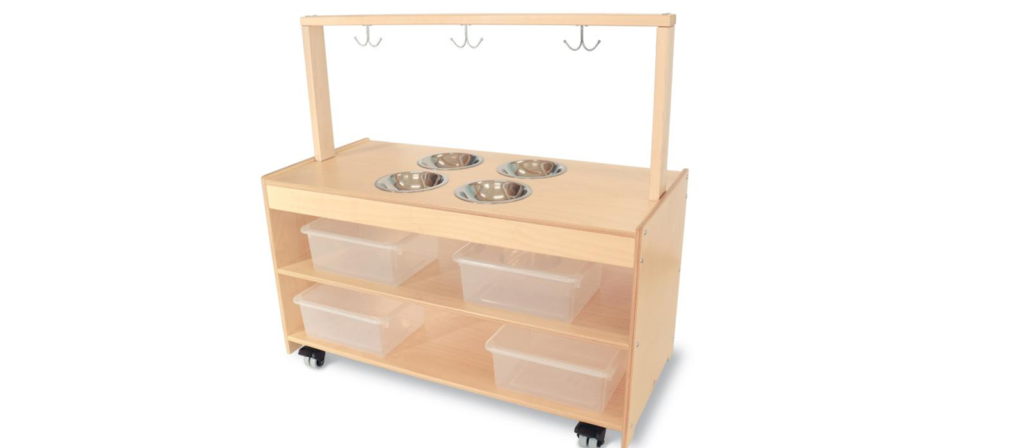
Mobile Sensory Table with Trays & Lids
This practical, classroom-ready model includes multiple trays with individual lids, allowing educators to switch between sensory themes with ease.
Key Features and Benefits:
- Easy Material Rotation: Enables quick changes from rice to water beads or foam.
- Hygiene-Friendly: Lids help maintain sanitation standards in shared environments.
- Organized Design: Built-in shelves and tray sections support structured exploration.
Ideal for classrooms focused on multiple learning stations and organized curriculum delivery.


Receive a free catalog and custom layout to help you design your ideal classroom easily.
Mud Kitchen and Outdoor Exploration Center
This rugged, weather-resistant model is built for outdoor learning. With real “sink” features, shelves, and pretend stoves, it’s designed to support messy, immersive nature-based play.
Key Features and Benefits:
- Connection to Nature: Encourages interaction with soil, plants, and water.
- Sensory Depth: Combines touch, smell, and visual experiences.
- STEM Learning: Children explore scientific ideas like mixing, measuring, and flow.
Best for Reggio-inspired or nature-based preschools aiming to bring learning outside.

Sand & Water Table for Outdoor
This sturdy outdoor sensory table is built to withstand frequent use in varied weather conditions. It supports open-ended group play with ample space and drainage systems.
Key Features and Benefits:
- Large Capacity: Accommodates multiple children for social learning.
- Durability: UV-resistant materials and built-in drainage for easy cleaning.
- Thematic Flexibility: Ideal for seasonal activities like “ocean,” “construction,” or “gardening.”
This table serves as a permanent fixture in outdoor play areas, enhancing environmental learning.

Sand and Water Clam-Shaped Sensory Table
With its playful clam-shell design, this table is visually engaging and invites curiosity. Its divided shell sections allow for the separation of materials or group rotation.
Key Features and Benefits:
- Child-Friendly Design: The unique shape draws attention and encourages exploration.
- Functional Separation: Allows educators to set up multiple sensory themes in one unit.
- Easy Drainage and Storage: Makes cleanup simple for water-based play.
Perfect for beach or marine-themed classrooms, this unit adds novelty to structured sensory play.


Receive a free catalog and custom layout to help you design your ideal classroom easily.
FAQs
- What is the best type of sensory bins for toddlers in small classrooms?
For compact learning environments, the Clear-View Sand and Water Tray Table is one of the most space-efficient sensory bins for toddlers. Its transparent design encourages visual observation while offering hands-on tactile engagement. It’s perfect for individual or small-group use where floor space is limited but educational impact is still essential.
2. How can we ensure cleanliness when using sensory bins for toddlers in group settings?
Maintaining hygiene with sensory bins for toddlers is crucial, especially in classrooms with frequent rotations. The Mobile Sensory Table with Trays & Lids allows each child to interact with a separate tray, minimizing shared contact. Lids provide easy storage and protection between sessions, making sanitation and material management much more efficient.
3. Which type of sensory bins for toddlers is best suited for outdoor learning activities?
The Sand & Water Table for Outdoor Learning Environments is a durable option specifically designed for outdoor sensory bins for toddlers. It supports messy, hands-on exploration with water, sand, and natural elements while withstanding weather and frequent use. Built-in drainage and UV protection make it ideal for schools that prioritize outdoor play.
4. How do sensory bins for toddlers support more than just tactile development?
While sensory bins for toddlers primarily enhance touch-based learning, products like the Mobile Sensory Play Kitchen also support dramatic play, communication, and real-world role modeling. Toddlers can simulate cooking, washing, and organizing—boosting language skills, sequencing, and early social-emotional growth, all within a tactile learning framework.
5. Why are mud kitchens considered high-value sensory bins for toddlers in nature-based programs?
The Mud Kitchen and Outdoor Exploration Center offers one of the most immersive sensory bins for toddlers by combining natural textures with imaginative play. Ideal for Montessori and Reggio-inspired programs, it encourages hands-on interaction with water, soil, and organic materials—fostering environmental awareness, motor development, and open-ended learning.
Conclusion
When thoughtfully selected and properly integrated into the classroom, sensory bins for toddlers offer far more than simple play—they become powerful tools for sensory development, early academic learning, social interaction, and emotional regulation. From compact indoor tables like the Clear-View Tray to rugged outdoor solutions like the Mud Kitchen, each sensory bin setup serves a specific educational purpose. Whether your preschool prioritizes mobility, hygiene, nature-based learning, or imaginative play, there’s a tailored option available. By investing in the right types of sensory bins for toddlers, educators can create dynamic, engaging, and developmentally rich environments that support early learners across multiple domains.







